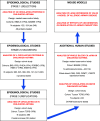Creatine Kinase Is Decreased in Childhood Asthma
- PMID: 35876143
- PMCID: PMC10870915
- DOI: 10.1164/rccm.202010-3746OC
Creatine Kinase Is Decreased in Childhood Asthma
Abstract
Rationale: The identification of novel molecules associated with asthma may provide insights into the mechanisms of disease and their potential clinical implications. Objectives: To conduct a screening of circulating proteins in childhood asthma and to study proteins that emerged from human studies in a mouse model of asthma. Methods: We included 2,264 children from eight birth cohorts from the Mechanisms of the Development of ALLergy project and the Tucson Children's Respiratory Study. In cross-sectional analyses, we tested 46 circulating proteins for association with asthma in the selection stage and carried significant signals forward to a validation and replication stage. As CK (creatine kinase) was the only protein consistently associated with asthma, we also compared whole blood CK gene expression between subjects with and without asthma (n = 249) and used a house dust mite (HDM)-challenged mouse model to gain insights into CK lung expression and its role in the resolution of asthma phenotypes. Measurements and Main Results: As compared with the lowest CK tertile, children in the highest tertile had significantly lower odds for asthma in selection (adjusted odds ratio, 95% confidence interval: 0.31; 0.15-0.65; P = 0.002), validation (0.63; 0.42-0.95; P = 0.03), and replication (0.40; 0.16-0.97; P = 0.04) stages. Both cytosolic CK forms (CKM and CKB) were underexpressed in blood from asthmatics compared with control subjects (P = 0.01 and 0.006, respectively). In the lungs of HDM-challenged mice, Ckb expression was reduced, and after the HDM challenge, a CKB inhibitor blocked the resolution of airway hyperresponsiveness and reduction of airway mucin. Conclusions: Circulating concentrations and gene expression of CK are inversely associated with childhood asthma. Mouse models support a possible direct involvement of CK in asthma protection via inhibition of airway hyperresponsiveness and reduction of airway mucin.
Keywords: asthma; biomarkers; creatine kinase.
Figures



Comment in
-
UnloCKing the Role of Creatine Kinase in Childhood Asthma.Am J Respir Crit Care Med. 2023 Mar 1;207(5):499-500. doi: 10.1164/rccm.202208-1552ED. Am J Respir Crit Care Med. 2023. PMID: 35984777 Free PMC article. No abstract available.
References
Publication types
MeSH terms
Substances
Grants and funding
LinkOut - more resources
Full Text Sources
Medical
Research Materials
Miscellaneous

